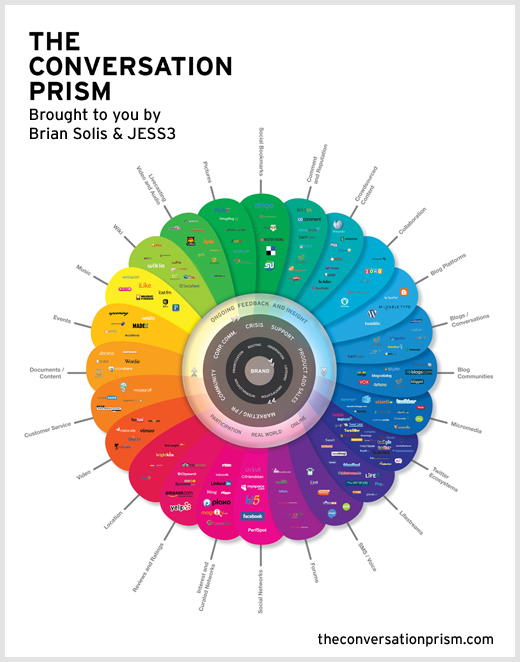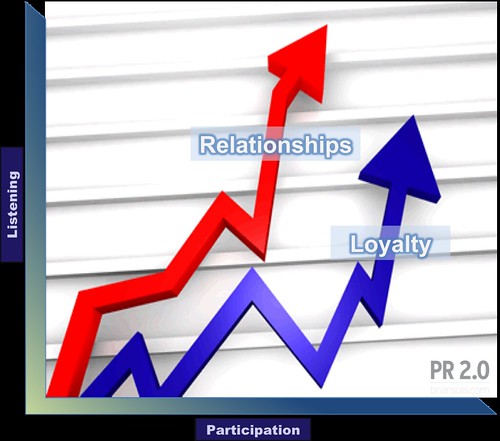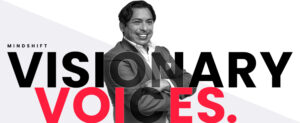I admire the work of Valeria Maltoni. Over the years, we’ve shared our individual ideas and vision for discovering, monitoring, and measuring relevant conversations in order to effectively chart the corporate landscape and identify opportunities for mutually beneficial engagement and learning. We’ve decided to collaborate to weave our experiences and advice into one post that we hope helps you unravel the confusion stemming from value over hype when evaluating Social Media as a channel for presenting, interacting, and observing.

As public relations, communications, and new media marketing professionals, it’s our job to identify the communities where our customers, peers, and also influencers communicate with each other in a way that’s transparent and frictionless. It’s how we build relationships and how we establish our personal and corporate social capital while simultaneously increasing intellectual equity.
Social Networks are magnets for marketers, but the people who define each online community are growing reticent to their hollow attempts at connecting as a means to create or extend a channel for broadcasting messages in a one-to-many hyperbole assault.
True social marketing is not marketing at all. The new era of communications necessitates personalization through a genuine and humanized approach. It fuses marketing, service, sociology, psychology, creativity, sales, and a dedicated practice of transparent Social Customer Relationship Management (sCRM).
Here’s why this is hard for companies – internally, the organization of work is still centered around a product or a service, things are seen from the inside out. Sometimes the delivery mechanism of that product is mistaken for the product itself.
For example, newspapers identified their product very closely with paper – thus requiring printing production plants, distribution models, and sponsors (advertising). The infrastructure created around the news to make it a business held it inside a specific model. The job of getting the news today is performed in hundreds of different ways – all vying for our attention. How could news organizations become more agile and relevant in this new context?
Technology Versus Social Sciences
Social media is not governed by the media or technology that facilitate online interaction, contribution, or participation. It is defined by the people, the communities they join, and the parallel cultures and behavior that manifest. Technology and the networks that spawn through constant innovation will continually surface, merge, excel, or vanish. Human nature and the desire to connect, interact, and elevate is perpetual.
The Conversation Prism – (get the poster here)
Using the Conversation Prism , we can visualize and map the shifting landscape of social networks and micro communities to observe and conduct our initial fieldwork through digital anthropology. The process reveals everything, from measurement opportunities to participation strategies to the specific infrastructure changes necessitated by the new proactive and reactive process of engagement in the social Web.
How can organizations learn to participate? Employees are a company’s first community. Right now companies tend to manage the flow of information through their internal social networks in the same ways they manage the technology installed on each associate’s laptop. Companies can and will get ahead when they learn to educate, engage with, and empower the natural grass roots communities that form around projects. The Conversation Prism can help visualize existing participation.
Listening
The first step is to “listen,” by searching keywords that populate and bind our marketplace. They include our company name, brands, competitors, and other related product and business descriptors. By assessing the volume, frequency and tonality of conversations throughout each network, we can establish The Conversation Index (CI), a benchmark to assess the state of our brand in the Social Web and also serve as a metric of which to compare our future activity to past presence and brand perception
We can not measure what we do not know. We need a baseline that extends across the Social Web, beyond blog posts and Twitter.
Elements necessary to define, identify and capture The Conversation Index:
– Timeframe
– Keywords
– Quantity of mentions vs. competition, total and by channel
– Tonality
– Potential for response, if so, from which department
– Reach of mention within each network (web traffic, subscribers, followers, retweets, linkbacks)
– Action (note that Social Media begets unique programs that drive discernible clickpaths so that you have visibility into measurable activity. Create a dedicated URL for the campaign and use Google or NuConomy analytics – YOU, not the Web team, use link shortneners that provide quantifiable numbers at the point of click such as Bit.ly and Poprl, use BackTweets.com to track the volume of link sharing.)
The Conversation Index is measured first for a baseline and then at regular intervals to draw comparisons and insight. The CI is also helpful to capture sentiment, reactions, visibility, action, and feedback surrounding specific events, leading up to, during, and following the landmark.
Imagine what would happen if everyone in your organization was a brand steward. Have you taught your teams what they should be listening for? People are not merely a company’s best assets, they are its best technology. Along with the potential for relevant and valuable content, which is the lifeblood of social media, you need more ears and hearts on the ground.
Social networks can and do extend beyond the company’s walls, yet few organizations have learned to recognize, encourage and embrace the talent they already have. The ones that have and do, can measure the results beyond anecdotal evidence.
Presentation
When documenting the results during the listening exercise, it’s absolutely critical to capture persuasive and credible criteria in a way that’s presentable and incontestable to decision makers. For those without graphic artists at the ready, recording the data above in a spreadsheet and exporting key findings as charts in a visual presentation will establish a compelling case and benchmark for further endeavoring into socialized engagement, as well as the ability to reference past status.
Formalizing the research creates a process that serves as a manageable workflow and procedure for all future aspects of tracking and documenting and reporting the details mined from listening, measurement, perception, and learning.
What are you going to do with all the data? While many companies have good ways to capture historical data through quantitative and qualitative research, the process and discipline do not include action steps beyond the tweaking of a campaign. That’s not deep enough. It means that you’re not willing to let what you hear and see change the way you do business.
In a nutshell, new marketing means that what you learn does not affect just how you present yourself – it impacts what you bring to the table.
Observation
Communities support each other. Citizens actively help others make decisions, offer suggestions and referrals, proactively share negative experiences, and repeatedly ask question – with or without our participation.
Doc Searls calls this Vendor Relationship Management (VRM). Others refer to it as Customer Relationship Management (CRM). But, as we are quickly learning, “management” and “relationships” are as distant from each other as their intentions. Perhaps it’s better stated as Community Relations or better yet, Public Relations.
Either way, we are missing opportunities right now.
Once our target networks are identified and our Conversation Index is documented, we must observe the conversational ecosystem within each network to understand the corresponding culture and behavioral dynamics. This is why new communications in the social economy requires a crash course in social sciences such as Anthropology, Sociology, and Ethnography.
We learn, earn credibility, and procure strategic intelligence through immersion.
The insight that we learn from listening and observing reveals dedicated and intermittent conversation ecosystems that spotlight real world brand perception and the potential for evangelism and also potential crisis. It resets intentions, crystallizes engagement strategies, influences how we adapt our story to each community, it humbles us, and introduces empathy into the process of connecting.
Can you give power to your customers? If your company has a customer Advisory Board, how can you work towards a true democratization of their influence over what you offer? Do you provide a forum for customers not just to tell you what they think, but to teach and share what they know with their peers?
Facilitating a peer community is probably one of the best ways to grow your corporate social capital while simultaneously increasing intellectual equity.
To excel in Social Media, we have to embrace modesty and refrain from the projection of vanity. Negativity is onerous. Unwelcome feedback is grueling to swallow. Whether or not it’s right or wrong, it’s still real world perception and it impacts our bottom line.
We have to be open.
Let it touch us.
Adapt
Reaction, change, and the practice of listening, hearing, and responding is the art and science of instilling trust and confidence that feed communities and determine the health and prosperity of brand resonance.
Allowing outside stimulus instead of reflecting or disregarding it is the art of embracing and embodying transparency and practicing genuine, unbiased engagement to facilitate meaningful relationships. Otherwise, transparency and engagement are merely yet another buzzword in the quiver of marketing arrows.
Productive and mutually beneficial engagement is powered by effective listening and productive participation that results in measurable and favorable action. It’s not only measured by the Conversation Index, but also by the sales, referrals, relationships and ensuing brand loyalty that escalate, and sometimes dip, in reaction to our contribution.
We earn the rewards or consequences we deserve.
So much of this is new to us. However, as marketers we’re learning how to excel and succeed in the new age of traditional and new influencers as they wrestle with relevance in the face of newfound opportunity.
Influence IS the ability to listen, learn, engage and inspire measurable actions. It’s also the observable progress people make as a result of an engagement with us.
Helpful Posts on PR 2.0:
– A New Search Engine for Twitter
– Social Media Influences Buying Decisions
– Can The Statusphere Save Journalism?
– Is Social Media Recession Proof?
– Facebook Now 200 Million Strong
– Twitter Traffic Surges to 10 Million
– The End of the Innocence
– The Social Effect
– Putting the Public Back in Public Relations is Now Available
– Twitter and Social Networks Usher in a New Era of Social CRM
– The Human Network = The Social Economy
– In the Statusphere, ADD Creates Opportunities for Collaboration and Education
– Humanizing Social Networks, Revealing the People Powering Social Media
– Social Networks Now More Popular than Email; Facebook Surpasses MySpace
– Are Blogs Losing Authority to the Statusphere?
– I Like You The Emerging Culture of Micro Acts of Appreciation
– The Ties that Bind Us – Visualizing Relationships on Twitter and Social Networks
– Make Tweet Love – Top Tips for Building Twitter Relationships
– The Battle for Your Social Status
– Twitter Tools for Communication and Community Professionals
– Is Twitter a Viable Conversation Platform
– Free eBook: The Essential Guide to Social Media
—
Connect with me on:
Twitter, FriendFeed, LinkedIn, Tumblr, Plaxo, Plurk, Identi.ca, BackType, Social Median, or Facebook
—
Subscribe to the PR 2.0 RSS feed.
![]()
—
Now available:


—
Image Credit
—
pr pr+2.0 pr2.0 public+relations marketing advertising interactive social+media socialmedia brian+solis social media media2.0 media+2.0 2.0 smo social+media+optimization marcom communication publicity conversation+prism conversation index conversational dialogue brand branding customer+service scrm crm








 Thr
Thr






Brian, this is one fascinating read. Thanks. And check out my latest on Twitter.
This gives a name to what I’ve been trying to do in my new assignment! Thanks for the insight. Would love to know your thoughts on doing this with very limited human resources, though.
-Nicole.
Very well done. Keep supporting your PR blogs with relevant stats.
Useful blog.Thank you for given.
For more jobs visit http://www.staffingpower.com
Useful blog.Thank you for given.
For more jobs visit http://www.staffingpower.com
I wouldn¡¯t comment on posts but I felt that I had to as your writing style is really good. You have broken down a difficult area so that it easy to understand. I think that you would enjoy reading what another good blogger has to say on the subject.
Well , the view of the passage is totally correct ,your details is really reasonable and you guy give us valuable informative post, I totally agree the standpoint of upstairs. I often surfing on this forum when I m free and I find there are so much good information we can learn in this forum!
multi-cavity
Here elaborates the matter not only extensively but also detailly .I support the
write's unique point.It is useful and benefit to your daily life.You can go those
sits to know more relate things.They are strongly recommended by friends.Personally!
http://www.you-rselfas.com